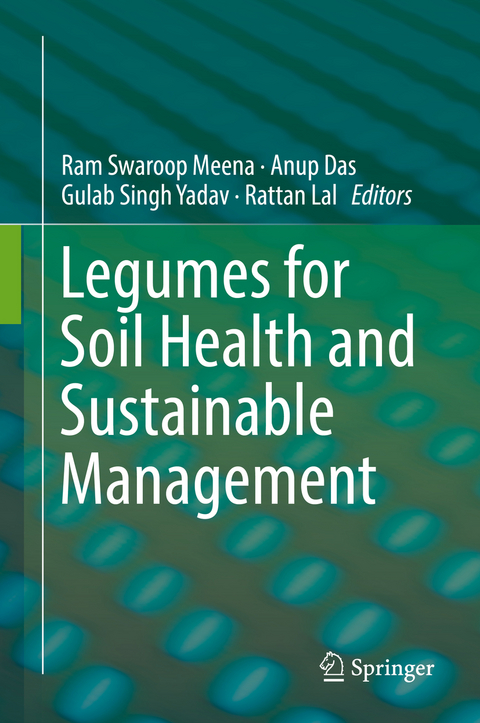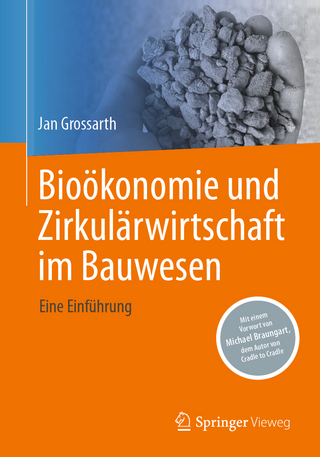
Legumes for Soil Health and Sustainable Management
Springer Verlag, Singapore
978-981-13-0252-7 (ISBN)
Including legumes in cropping systems is an important toward advancing soil sustainability, food and nutritional security without compromising soil quality or its production potential. Several textbooksand edited volumes are currently available on general soil fertility or on legumes but‚ to date‚ none have been dedicated to the study of “Legumes for Soil Health and Sustainable Management”. This is important aspect, as the soil, the epidermis of the Earth (geoderma)‚ is the major component of the terrestrial biosphere. This book explores the impacts of legumes on soil health and sustainability, structure and functioning of agro-ecosystems, agronomic productivity and food security, BNF, microbial transformation of soil N and P, plant-growth-promoting rhizobacteria, biofertilizers, etc.
With the advent of fertilizers, legumes have been sidelined since World War II, which has produced serious consequences for soils and the environment alike. Therefore, legume-based rational cropping/soil management practices must support environmentally and economically sustainable agroecosystems based on (sequential) rotation and intercropping considerations to restore soilhealth and sustainability. All chapters are amply illustrated with appropriately placed data, tables, figures, and photographs, and supported with extensive and cutting-edge references. The editors have provided a roadmap for the sustainable development of legumes for food and nutritional security and soil sustainability in agricultural systems, offering a unique resource for teachers, researchers, and policymakers, as well as undergraduate and graduate students of soil science, agronomy, ecology, and the environmental sciences.
Ram Swaroop Meena is working as an Assistant Professor in the Department of Agronomy, Banaras Hindu University (IAS, BHU). Dr. Meena has awarded for the Raman Fellowship from the MHRD, GOI. He has completed his Post-Doctoral research on soil carbon sequestration under Prof. Rattan Lal, Distinguished Scientist and Director, Carbon Management and Sequestration Centre (C-MASC), Ohio State University, USA. He is working on soil sustainability, crop productivity and resources use efficiency, under current climatic era. Dr. Meena is supervised 12 PG and 4 Ph.D. students, and he has 8 years research and teaching experience at UG/PG/Ph.D. level. Dr. Meena has published more than 90 research and review papers in peer-reviewed reputed journals, and contributed in the edited books with 25 book chapters at national and international level. He has published 3 books on the national and another 3 on the international level. He has awarded form the several awards and a member of 9 reputed national and international societies, and working as a general secretary, editor; member of editorial board in twelve national, international peer-reviewed reputed journals, and attended several national and international conferences in the country and abroad. Anup Das, Principal Scientist (Agronomy) and Head, Division of Crop Production, Indian Council of Agricultural Research (ICAR), Research Complex for North Eastern Hill Region, Umiam, Meghalaya. He has undergone special attachment under Prof. Rattan Lal, Distinguished Scientist and Director, C-MASC, Ohio State University, USA. Dr. Das has four years Post Graduate teaching experience in College of Post Graduate Students (CPGS), Central Agricultural University (CAU), Umiam, Meghalaya and guided and co-guided 17 Masters and one Ph.D. student of CPGS, Umiam and IARI, New Delhi. He has in his credit 115 research papers, 15 books, 27 technical bulletins and 52 book chapters. He is reviewer and Editor of about 25 National and International Journals. Dr. Anup Das is presently the Secretary, Indian Association of Hill Farming and Chief Editor of Innovative Farming- an international quarterly open access journal. He is recipient of many National awards and recognitions like NAAS Associate fellow, Lal Bahadur Shastri outstanding Young Scientist Award, Swami Sahajanand Saraswati outstanding extension scientist award, Outstanding interdisciplinary team research award, Fakhruddin Ali Ahmed award for contribution to tribal farming system, Dr. HK Jain- CAU award for excellence in agricultural research in North Eastern states, Dr. KG Tejwani Award for natural resource management, among many others. Gulab Singh Yadav is working as Scientist (ARS)-ICAR,GOI. Dr. Yadav recipient of UP Rajaya Krishi Utpadan Mandi Parishad Scholarship, JRF and SRF-ICAR, and Ph.D. (Agronomy), respectively. He had completed the Postdoctoral research under the supervision of Prof. Rattan Lal, a renowned soil scientist from C-MASC, Ohio State University, USA. He has involved in 6 externally funded projects and 4 Institutional Projects as Principal and Co-Principal Investigators. He has in his credit more than 50 research papers in International and National journals and several technical bulletins, book chapters, review and popular articles. He is reviewer of about 10 National and International Journals. He is recipient of best Research Scientist award-2016 of ICAR Research Complex for North Eastern Hill Region, Tripura Centre, West Tripura, India and DBT Associate -2016, Government of India. He is also a recipient of prestigious D.N. Borthakur award (Team award) for farming system research in North East India. Presently, he is a life member of several professional scientific societies. Rattan Lal, Ph.D., is a Distinguished University Professor of Soil Science and Director of the Carbon Management and Sequestration Center, TheOhio State University, and an Adjunct Professor of University of Iceland. He received B.S. from Punjab Agricultural University, Ludhiana; M.S. from Indian Agricultural Research Institute, New Delhi and Ph.D. from the Ohio State University. He served as Sr. Research Fellow with the University of Sydney, Australia (1968-69), Soil Physicist at IITA, Ibadan, Nigeria (1970-87), and Professor of Soil Science at OSU (1987-to date). He has authored/co-authored 868 refereed journal articles and 506 book chapters, has written 20 and edited/co-edited 69 books. He is included in the Thomson Reuters list of the World’s Most Influential Scientific Minds (2014, 2015), and among the most cited scientists (2014, 2015, 2016 and 2017). He received the Honoris Causa degree from five universities in Europe and Asia, and is fellow of the five professional societies. Dr. Lal mentored 110 graduate students and 169 visiting scholars from around the world. Prof. Lal was a lead author of IPCC (1998-2000), and was awarded Nobel Peace Prize Certificate by IPCC in 2007, and Global Dryland Champion of the United Nations Convention to Combat Desertification, Bonn, Germany in 2013. He was President of the World Association of Soil and Water Conservation (1987-1990), International Soil and Tillage Research Organization (1988-1991), Soil Science Society of America (2006-2008) and is the current President of the International Union of Soil Sciences (2017-2018).
Chapter 1. Legumes and Sustainable Use of Soils.- Chapter 2. Cereal-Legume Cropping System In Indian Himalayan Region For Food and Environmental Sustainability.- Chapter 3. Grain Legumes for Resource Conservation and Agricultural Sustainability in South Asia.- Chapter 4. Role of Legumes in Soil Carbon Sequestration.- Chapter 5. Perennial and Intercrop Legumes as Energy Crops for Biogas Production.- Chapter 6. SymbioticTripartism in the Model Plant Family of Legumes and Soil Sustainability.- Chapter 7. Rhizobium-Legumes Symbioses: Heavy Metals Effects and Principal Approaches for Bioremediation of Contaminated Soil.- Chapter 8. Harnessing Soil Rhizobacteria for Improving Drought Resilience in Legumes.- Chapter 9. Nitrogen and Legumes: A Meta-analysis.- Chapter 10. Leguminous Trees an Innovative Tool for Soil Sustainability.- Chapter 11. Cereal+Legume Intercropping: An Option for Improving Productivity and Sustaining Soil Health.- Chapter 12. Legumes Green Manuring- an Option for Soil Sustainability.- Chapter 13. Legume Plant Growth-Promoting Rhizobacteria (PGPRs): Role in Soil Sustainability.- Chapter 14. Biofertilizers: A Sustainable Approach for Pulse Production.- Chapter 15. Role of Soil Phosphorus on Legume Production.- Chapter 16. Grain legumes: Impact on Soil Health and Agro-Ecosystem.
| Erscheinungsdatum | 21.09.2018 |
|---|---|
| Zusatzinfo | 75 Illustrations, color; 7 Illustrations, black and white; XI, 539 p. 82 illus., 75 illus. in color. |
| Verlagsort | Singapore |
| Sprache | englisch |
| Maße | 155 x 235 mm |
| Themenwelt | Naturwissenschaften ► Biologie ► Ökologie / Naturschutz |
| Naturwissenschaften ► Geowissenschaften ► Geologie | |
| Weitere Fachgebiete ► Land- / Forstwirtschaft / Fischerei | |
| ISBN-10 | 981-13-0252-9 / 9811302529 |
| ISBN-13 | 978-981-13-0252-7 / 9789811302527 |
| Zustand | Neuware |
| Haben Sie eine Frage zum Produkt? |
aus dem Bereich


